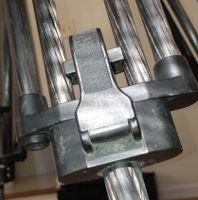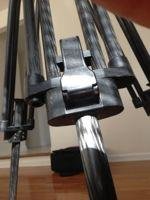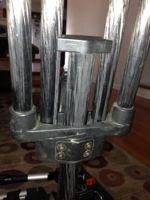
Grant Peacock
Basic Member-
Posts
8 -
Joined
-
Last visited
Profile Information
-
Occupation
Cinematographer
-
Location
Washington DC
-
My Gear
Sony PMW-F5, Canon EOS C300 MkII, C300, multiple ENG cameras
-
Specialties
Live television Washington DC, documentary production, ENG story telling, lighting.
Contact Methods
-
Website URL
http://www.gpi.tv
-
Reviving an old thread here, as I'm not able to find anything else about this. I should count myself lucky that of the 2 C300 Mk1 units I have here, it was only recently that I have experienced a failure in one camera with the internal battery - I may be able to call it a 'reference cell' here, as it probably only has the function of maintaining volatile memory. My suspicion around the issue of the internal 'battery' (it's probably a cell, technically speaking) is that the life of the cell would be extended if the camera were maintained on the shelf with the power adaptor attached. It makes sense that there is a certain leakage current associated with an unused camera otherwise. What would be interesting to find out is whether leaving one of the camera's regular battery packs (the rechargeable BP-series LiOn packs that you use for portable work) would help delay the degradation. I am currently in touch with Canon about the replacement cell issue, while they have my camera on the bench, and I can post a follow-up here about what, if anything, further I am able to learn from their tech staff about this.
-
Update from here : the ballast just produced a burning smell and is dead. Last time I checked, we did not have a repair shop on the East Coast (we're near Washington DC). I have used Galaxy Lighting in the past (CA). Does anyone know if we currently have a closer facility? Grant.
-
Thanks Joseph. Hot restrike may have happened once during the day. The power is being run over a long distance, so I've asked crew to get a multimeter across the 120 volt wall receptacle, and then again check at the other end, where it meets the input to the ballast. Thanks again for thinking of this issue. - Grant.
-
This 1200 PAR HMI, with 575/1200 e-ballast, has worked reliably in the past, but today has developed strange behaviour, something not seen before : Day 1, it worked great and was on all day. Then it was turned off and during restart had an issue where the lamp pulsed once during strike but would not stay lit. Waited a while between strikes and didn't get it back on. A crew member opened it up, and the bulb looked cloudy in the middle so he figured it was a dead bulb. Changed to another bulb that had looked already used. First try striking it, same result. We have re-seated all connections, have verified that we're energizing ballast before supplying power to head, and also to note that this unit is running on house power, not an on-site generator's output. Shoot is indoors, so dampness is not a factor. The ballast has very little time on it. Is there anything else that we should try in terms of troubleshooting? We're nervous about repeatedly loading fresh lamps, in case something is happening that could be damaging each lamp during re-strike.
-
I own a total of 15 Kino lighting systems (DIVA 400’s and 4ft 4Banks). I need to tap into any available expertise on the best way to look after these systems over the longer term. Here’s a case in point - I just loaded up a ballast, got a nasty burning smell. I cut power and found that the wiring on 2 sockets was swapped over. A basic mistake that could have destroyed a ballast. With this in mind, I would benefit from a working set of ‘rules of the road’ that can be followed to protect the gear for longevity. One thing I have always tried to do is only plug in ballasts once all other connections are in place (assuming that a ballast without a load connected may be damaged as it tries to fire up a tube that isn’t there). Added to that procedure is my new rule-to-self - check all the socket connections before putting any heads up on stands. I also have one specific unresolved question - as tubes accumulate hours, is it okay to just wait for them to fail, or is there a better maintenance practice? I wonder out aloud if a tube at the point of failure is adding a lot of stress to the ballast’s output section? (ie : does the start-up impedance of a tube go up greatly as it gets older?) I use my complete set of lights a few times per year (specific client & lighting plot) and hire around the mid-Atlantic locally, so I am working with grip/PA's with varying degrees of knowledge and established practices. I would like to boil everything down to a must-do sequence of assembly and checks along the way. Cheers, Grant.
-
Hello Randy, Grant here. Are you still looking for a Super16 camera?
-
Hello George, I just released one of these units for consignment sale. It was used only for the last elections (several days of live shots). My concern was that there were very few available replacement lamps for it. Supply was getting so scarce in fact that I was wondering about finding a talented engineer to retrofit it to a different lamp. In the end, I ran out of time and sold the kit. Did you ever learn more about this HMI yourself?
-
I own two Sachtler tripod systems, but both were purchased as used gear (lacking supporting docs with their acquisition). Exploring Sachtler's web pages and downloadable docs, I see nothing on doing basic servicing and adjustments. I have leg locks beginning to slip on a carbon-fiber, 3 stage system. I'm cautious about making adjustments without prior advice, as carbon fiber can easily be damaged. Can anyone point me to existing information on making these clamp adjustments? Four images attached. Thanks. Grant.
- 2 replies
-
- sachtler
- tripod repair
-
(and 2 more)
Tagged with:





